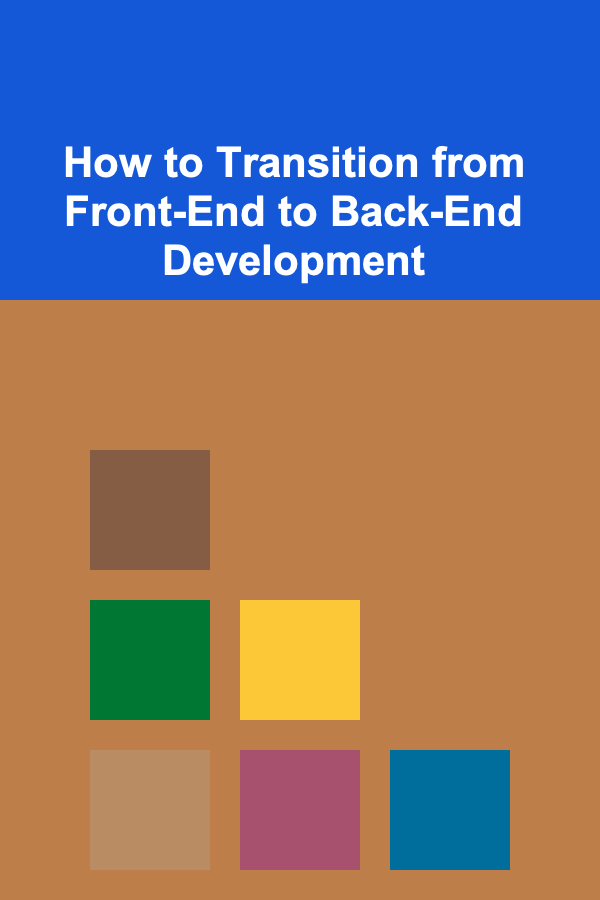
How to Transition from Front-End to Back-End Development
ebook include PDF & Audio bundle (Micro Guide)
$12.99$10.99
Limited Time Offer! Order within the next:

The world of web development is vast and multifaceted, with developers often specializing in either front-end or back-end development. However, many developers find themselves intrigued by both aspects of the field and eventually seek to broaden their skill set. For those who have spent time honing their expertise in front-end development, transitioning to back-end development can be a challenging yet highly rewarding endeavor.
In this article, we will explore the essential steps and considerations for making the shift from front-end to back-end development. From understanding the differences in roles to learning new programming languages and tools, this guide will provide you with a roadmap for a smooth and successful transition.
Understanding the Key Differences Between Front-End and Back-End Development
Before diving into the technical aspects, it's important to understand the fundamental differences between front-end and back-end development. These distinctions will provide you with a clearer perspective on what you're about to learn and why these changes are necessary for the transition.
1.1 Front-End Development: The User-Facing Side
Front-end development focuses on the client side of web applications---the parts that users interact with directly. This includes the design, layout, structure, and interactivity of a website. Front-end developers typically use HTML, CSS, and JavaScript to create a visually appealing and functional user experience.
Key aspects of front-end development:
- Languages Used: HTML, CSS, JavaScript, and front-end frameworks like React, Angular, and Vue.
- Responsibilities: Designing the UI/UX, implementing the layout, ensuring responsiveness, and handling user interaction.
- Tools: Text editors (VS Code, Sublime), build tools (Webpack, Gulp), version control (Git).
1.2 Back-End Development: The Server Side
Back-end development deals with the server-side of a web application. This includes the server, database, and application logic that power the front-end interface. Back-end developers ensure that data is correctly handled, processed, and stored, while also maintaining the security, performance, and scalability of the application.
Key aspects of back-end development:
- Languages Used: PHP, Python, Java, Ruby, Node.js, C#, Go, etc.
- Responsibilities: Managing databases, handling requests from the client side, implementing business logic, ensuring security and scalability, and integrating APIs.
- Tools: Database management systems (MySQL, PostgreSQL, MongoDB), web frameworks (Django, Flask, Express, Spring), cloud services (AWS, Azure).
Why Transition to Back-End Development?
There are many reasons why a front-end developer might choose to switch to back-end development. Let's explore some of the most common motivations:
- Desire for Full-Stack Expertise: Many developers seek to become full-stack developers, capable of handling both front-end and back-end responsibilities. This can increase your employability and career opportunities.
- A Stronger Focus on Data: Back-end development often involves working with databases, algorithms, and complex data manipulation. If you enjoy working with data and problem-solving, back-end development may be a natural fit.
- Increased Career Growth: Back-end development is often associated with higher salaries and more senior roles. Mastering both ends of development can lead to more lucrative opportunities.
- Curiosity and Interest: Some developers simply find back-end development fascinating and want to expand their knowledge beyond the front-end.
Learning the Necessary Skills for Back-End Development
Making the transition from front-end to back-end development will require you to learn several new skills. While some of the skills you've learned as a front-end developer (such as problem-solving, version control, and general programming principles) will carry over, back-end development introduces new languages, tools, and concepts. Let's explore the essential skills you'll need to acquire.
3.1 Programming Languages
As a front-end developer, you're already familiar with JavaScript, but back-end development often requires learning additional programming languages. Here are some of the most common ones:
- Node.js (JavaScript): If you're already familiar with JavaScript, transitioning to Node.js can be a seamless process. Node.js allows you to use JavaScript on the server side, and many frameworks (like Express) are built around it.
- Python: Known for its simplicity and readability, Python is a popular choice for back-end development. It's used in a variety of web frameworks, including Django and Flask.
- Ruby: Ruby on Rails is a widely used framework for building web applications quickly. Ruby is known for its clean syntax and developer-friendly environment.
- PHP: Despite facing criticism, PHP is still one of the most commonly used languages for back-end development, particularly in WordPress and similar content management systems.
- Java: Java is widely used for large-scale applications and enterprise solutions. It's known for its scalability and security.
- Go (Golang): A statically typed language developed by Google, Go is designed for performance and scalability, making it a great choice for high-performance web applications.
3.2 Database Management
Back-end development often involves working with databases to store, retrieve, and manipulate data. Understanding how to interact with databases is crucial for any back-end developer. You'll need to learn both relational databases (SQL) and NoSQL databases.
- SQL Databases : SQL databases use structured query language (SQL) to manage data. Common SQL databases include MySQL, PostgreSQL, and SQLite.
- Learn how to write SQL queries for data retrieval and manipulation.
- Understand database normalization and how to design an efficient schema.
- NoSQL Databases: NoSQL databases, such as MongoDB, are used for unstructured data and applications that require flexibility in data storage. You'll need to understand how to query and store data in these databases.
3.3 Web Frameworks
Back-end developers typically use web frameworks to simplify the process of building and deploying web applications. These frameworks provide a set of tools and libraries that streamline the development process. Some popular back-end frameworks include:
- Node.js Frameworks: Express.js is a minimalist framework for building web applications with Node.js.
- Python Frameworks: Django and Flask are two of the most popular Python web frameworks.
- Ruby on Rails: A highly opinionated web framework that encourages convention over configuration, making it easier to build applications quickly.
- Java Frameworks: Spring and Hibernate are common Java frameworks used for building scalable and secure web applications.
3.4 APIs and RESTful Services
As a back-end developer, you will need to learn how to build and consume APIs (Application Programming Interfaces) to allow the front-end to communicate with the server and vice versa. The most common type of API used in web development is a RESTful API.
- Learn how to design RESTful services, including HTTP methods (GET, POST, PUT, DELETE).
- Understand how to use JSON (JavaScript Object Notation) as the standard format for data exchange between the client and the server.
3.5 Security and Authentication
Security is a critical aspect of back-end development. You'll need to learn how to protect web applications from various security threats and vulnerabilities.
- Learn about authentication methods such as OAuth, JWT (JSON Web Tokens), and sessions.
- Understand encryption techniques, including SSL/TLS for securing communications and hashing algorithms for storing passwords securely.
3.6 Version Control
You're likely already familiar with version control through Git as a front-end developer. This skill will be equally important in back-end development, as it allows you to manage and track changes to your code over time.
- Learn how to use Git effectively, collaborate with others, and manage branching strategies.
Practical Steps to Make the Transition
Now that you know the necessary skills for back-end development, it's time to put them into practice. Here's a roadmap to help you make the transition:
4.1 Start with Small Projects
Begin by working on small back-end projects to get familiar with the technologies you're learning. Build simple APIs, work with databases, and experiment with frameworks. These projects will help you build confidence and solidify your knowledge.
4.2 Take Online Courses and Tutorials
There are numerous online resources available to help you learn back-end development. Platforms like Udemy, Coursera, freeCodeCamp, and Codecademy offer structured courses that cover everything from basic programming languages to advanced back-end concepts.
4.3 Collaborate with Back-End Developers
To accelerate your learning, collaborate with experienced back-end developers. Working alongside someone more experienced will expose you to industry best practices and help you learn new techniques more quickly.
4.4 Contribute to Open Source Projects
Contributing to open-source projects is a great way to gain real-world experience in back-end development. By working on established projects, you'll learn best practices and get hands-on experience with more complex systems.
4.5 Build a Full-Stack Application
Once you've gained proficiency in back-end development, try building a full-stack application. This will allow you to apply both your front-end and back-end skills, giving you a holistic understanding of web development.
Conclusion
Transitioning from front-end to back-end development is a challenging but rewarding journey. By learning new programming languages, tools, and concepts, you can broaden your skill set and unlock new opportunities in your career. Remember, the key to making a successful transition is persistence, practice, and a willingness to embrace new challenges. With time and effort, you can become a well-rounded developer capable of building complete web applications from front to back.
Reading More From Our Other Websites
- [Personal Care Tips 101] How to Apply Eye Cream to Get Rid of Morning Puffiness
- [Personal Investment 101] How to Diversify Your Portfolio: A Step-by-Step Guide
- [Digital Decluttering Tip 101] How to Clean Up Your Social Media Footprint While Preserving Your Business Presence
- [Home Holiday Decoration 101] How to Create a Welcoming Holiday Vibe with Outdoor Decorations
- [Home Cleaning 101] How to Keep Your Bathroom Sparkling Clean with Minimal Effort
- [Personal Finance Management 101] How to Build a Debt Repayment Plan That Works for You
- [Trail Running Tip 101] Gear Guide for Trail Runners: What to Wear and Pack for a Safe, Comfortable Run
- [Home Storage Solution 101] How to Build DIY Storage Solutions for a Customized Space
- [Small Business 101] Best Low‑Fee Payment Processors for Small Non‑Profits Accepting International Donations
- [Organization Tip 101] How to Store Books and Resources Effectively

How to Incorporate Global Holiday Traditions into Your Home Decor
Read More
How to Maximize Your Returns with Real Estate Investments
Read More
How to Start a Deep Learning Side Hustle for Passive Income
Read More
How to Use Inventory Templates for Easy Management
Read More
How to Utilize ChatGPT for Travel Planning
Read More
How to Use Printable Coupons for Local Business Advertising
Read MoreOther Products

How to Incorporate Global Holiday Traditions into Your Home Decor
Read More
How to Maximize Your Returns with Real Estate Investments
Read More
How to Start a Deep Learning Side Hustle for Passive Income
Read More
How to Use Inventory Templates for Easy Management
Read More
How to Utilize ChatGPT for Travel Planning
Read More